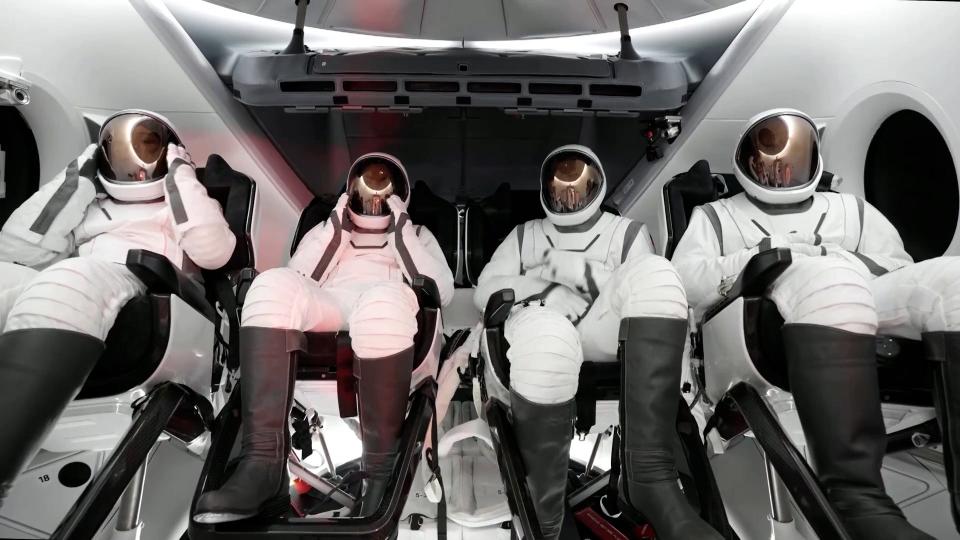SpaceX delays Polaris Dawn again, this time for 'unfavorable weather' for splashdown
SpaceX has again delayed the potentially historic Polaris Dawn commercial spaceflight mission that aims to send a four-member crew further into space than humans have been in more than 50 years.
The mission had been set to launch early Wednesday before SpaceX announced on the social media site X that the launch had been called off because of "unfavorable weather" forecast for the crew's return to Earth. The possibility of a Thursday launch is also now a no-go because of predicted conditions off the Florida coast, where the SpaceX Dragon capsule intends to make a water landing with the crew when the mission is complete, the company said.
The latest delay is the third since billionaire entrepreneur Jared Isaacman arrived with his crew more than a week ago at the Kennedy Space Center in Florida to prepare for the launch. Isaacman, who funded the mission along with Elon Musk's company, will command a crew that includes pilot Scott “Kidd” Poteet and SpaceX engineers Sarah Gillis and Anna Menon, both of them mission specialists.
The crew's ambitious spaceflight will attempt to take them to higher altitudes than humans have traveled since NASA's Apollo program in the 1970s. While in orbit, the Polaris Dawn crew also will conduct the first-ever commercial spacewalk and test SpaceX technology that could set the stage for future deep space exploration.
Polaris Dawn mission: What to know about historic commercial spacewalk mission for SpaceX
Why was Polaris Dawn delayed this time?
The Falcon 9 rocket carrying the Dragon was set to launch between 3:38 and 7:09 a.m. ET Wednesday before SpaceX scrubbed the launch Tuesday night.
The cancellation came after SpaceX officials detected bad weather in the forecast around the time the Polaris Dawn crew would be returning to Earth in the Dragon for a splashdown at one of seven sites off Florida.
Three launch delays so far, 1 for a helium leak
The delay is the third since the Polaris Dawn crew arrived in Cape Canaveral to make the final preparations for the mission.
Last week, SpaceX moved the launch window back from Monday to Tuesday to give teams more time to complete preflight checks. Then when Monday came, a helium leak on a piece a equipment designed to detach from the rocket during takeoff forced another delay.
Isaacman, founder of payments platform Shift4, said Wednesday night on X that the helium leak was repaired and the weather for the launch itself was ideal, if not the weather for the landing.
When will Polaris Dawn launch?
It's unclear yet just when SpaceX would be targeting a new launch window, but it won't be Thursday.
"Teams will continue to monitor weather for favorable launch and return conditions," SpaceX said.
Our launch criteria are heavily constrained by forecasted splashdown weather conditions. With no ISS rendezvous and limited life support consumables, we must be absolutely sure of reentry weather before launching. As of now, conditions are not favorable tonight or tomorrow, so… https://t.co/Zpd3pY5kNF
— Jared Isaacman (@rookisaacman) August 28, 2024
Sharing SpaceX's post, Isaacman added that "we’ll assess day by day."
"As Elon mentioned, Polaris Dawn is a challenging mission with critical objectives, so we’ll wait for the best opportunity to ensure success," Isaacman posted. "Sometimes, the hardest journeys require the most patience, and we’re ready to wait for the right moment."
The mission of Polaris Dawn
Polaris Dawn is the first of three human spaceflights under the Polaris Program, all of which are intended to test SpaceX technologies needed to carry humans deep into the cosmos.
The crew eventually plans to spend five days in orbit testing technology on behalf of SpaceX that could prove crucial as NASA and other space agencies set their sights on deep-space exploration, including destinations like Mars.

The launch itself should take the SpaceX Dragon capsule 870 miles above Earth – a trajectory that will take the crew through the treacherous inner regions of the planet's Van Allen radiation belts.
Once Polaris Dawn descends to a new cruising orbit at an altitude of about 435 miles, the crew will attempt to become the first nongovernment astronauts to do a spacewalk.
Because the Dragon does not have an airlock, the entire spacecraft will have to be depressurized when the hatch is opened, exposing the entire crew to the vacuum of space. All four astronauts will be wearing extravehicular activity (EVA) suits designed by SpaceX to receive oxygen through tethers, which they will test on behalf of the company.
The crew will also complete about 40 scientific experiments – many of which aim to understand the human body's reaction to long spaceflights – and test a new laser-based satellite communication system using Starlink.
Eric Lagatta covers breaking and trending news for USA TODAY. Reach him at [email protected].
This article originally appeared on USA TODAY: SpaceX delays Polaris Dawn launch due to splashdown weather forecast
